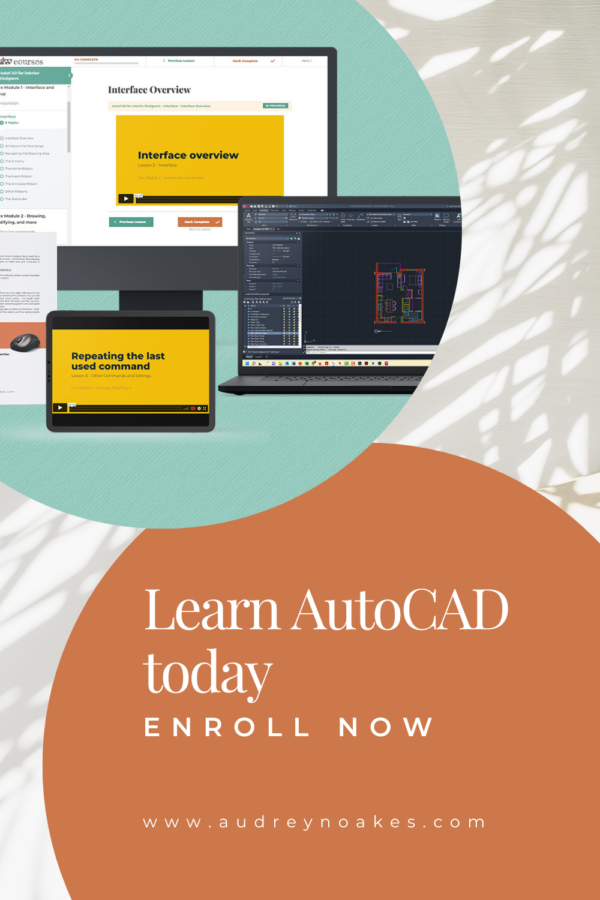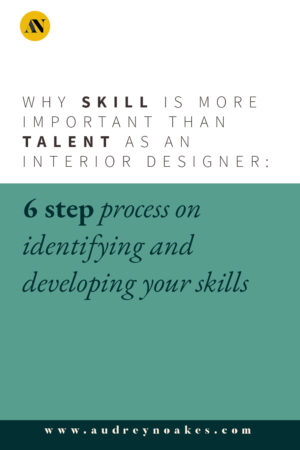Creative jobs like interior design almost always have to strike a balance.
There’s a balance between innate talent and learned skill. Some designers have gotten really far on talent alone.
But I think that’s a risky approach to take.
Why?
Digital skills have meant some of the innate talents possessed in the successful designers of the past have completely leveled the playing field.
These skills are easy to learn given the right attitude and approach.
So a talented designer alone will quickly find themselves outdone by competition if they don’t push and improve their skills too.
What’s the Difference Between Skill and Talent?
So what do we mean by talent and skill?
Talent refers to the things that come really naturally to you. A lot of time things that come to mind are people who are talented singers or talented artists. These are things that can obviously be improved by training and education, but these are also things that people can be naturally good at too.
In interior design, some talents that come to mind are spatial awareness, color perception, as well as just a critical eye. Again, these can absolutely be honed and improved, but often, designers’ have some natural talent in these areas.
Skill refers to a learned ability and in some cases an expertise in knowing how to do something.
Going back to our previous examples, a musician has honed a skill when it comes to a specific instrument. A ceramicist has honed a skill when it comes to a specific media. Each of these people probably got started with some innate talent but it was their skills that took them to that next level.
In interior design, some skills that come to mind are technical drawing, space planning, working with design elements, construction understanding, rendering, digital modeling, and so many more…
Why Skill is More Important Than Talent in Interior Design
So why is skill more important than talent in interior design?
Basically, there are a lot of skills as an interior designer. This means you can build your skills to fill any gaps in your talent. This also means your competition can build their skills and potentially overshadow your talents with these skills.
So talent can only get you so far.
Also, clients and the end users who experience our designs are becoming more savvy and knowledgeable in their own right.
So we have a more critical group of people our design work serves.
As a result, there are also growing expectations among this group of people.
Polished drawings, 3D rendered visuals, even virtual reality are all becoming not just a bonus but an expectation.
So you need to build these skills – and in this case? You need to build these digital skills.
How to Identify & Develop Your Interior Design Skills
So to know what skills you already possess and what skills you should hone and develop further, it takes a bit of self reflection. This doesn’t have to be hard, just take a half hour or so to think specifically about your skills.
Want a PDF worksheet to help you follow this process?
Step 1: What are you already doing well? And what are you doing not so well or not at all?
Make a big long list of all the things you know you do well as an interior designer.
Don’t be shy. Own your successes!
Then make a second list of everything you know you could be doing better or that you’re avoiding because you feel you don’t have the talent or the skills.
Step 2: Identify which of these things are your talents and which are your skills.
Look at your two lists and be honest.
On that first list, which ones are things you’ve just always been able to do well. And which ones are things that you’ve worked really hard to become excellent at.
If you’ve actually written out your list (I hope you have!), take two different color highlighters and highlight the talents in one color and the skills in another.
On that second list, we’re going to go ahead and say all of these are skills.
That means, even if you’re not good at it now or you can’t do it now at all, it doesn’t mean you can’t learn. (I’m of the opinion that everything is figureoutable – thanks, Marie Forleo).
Step 3: Look at your talents and see if they can be made more effective by adding to your skillset.
First, look at your talents and see if they are actually talents that you could put a bit more effort into becoming a full-blown skill.
For example, maybe you have a really good eye for color. That’s great!
What can you do to make that talent into a skill?
We’ll get into more detail about the actions to take to improve a skill in Step 6, but for now, maybe it’s to buy some books to not just flip through, but to study and analyze. Maybe it’s to sign up for a color expertise course. (I know people swear by Maria Killam’s color courses!)
Taking your natural talents one or two steps further is how you set yourself apart from a growing pool of competition – so identify which talents can become skills.
Step 4: Look at your talents that will become skills, your current skills, and any future skills you will develop, and see how they can be developed – by improving knowledge, streamlining processes, optimizing your tools, …
Now just because you’ve already identified an area you succeed as a skill doesn’t mean you have no work to do in that area.
Look at each area that you’ve identified as either a talent-turned-skill, a current skill, or future skill…
Or better yet, look at each area that you’ve identified as either a current or future asset, and decide if this is an area that you need:
- More knowledge and experience
- More systems and processes
- Better tools
Breaking it down into one of these three categories means you’ll have a good idea of where to start.
- Am I a beginner who needs an introduction to this skill?
- Am I needing to be more efficient and effective in this skill?
- Or do I simply need to make an investment to attain or improve this skill?
Step 5: Prioritize!
This step is so important. If you skip it, you’ll overwhelm yourself and never take any action on these skills so you’ll stay in the same spot – relying on any talent and current skill set.
This step is all about setting your priorities.
Look at all the skills that you’ve identified including their subsequent categories, and start putting numbers next to them – from 1 as most important and anything after that as not as important.
Once you’ve added this order of priority to your list. I want you to mentally block out everything but # 1, #2, and #3.
Now look at these top three priority skills.
What categories have they fallen under?
If they’re all in More knowledge and experience / I am a beginner who needs an introduction to this skill. Ignore #2 and #3 entirely. You only have to focus on one skill for now because it’s going to need most of your attention in the next few months.
If they’re all in More systems and processes / I am needing to be more efficient and effective in this skill. Ignore #3 entirely. You’re in a good place with these skills but you could be so much better. Choose the top two skills and give them the attention they need to be honed and systematized over the next few months.
If they’re all in Better tools / I simply need to make an investment to attain or improve this skill. Give all of your top 3 a little energy. In this case, you’re probably feeling pretty good about your knowledge and systems in this skill. You just want to invest in it from a more tangible standpoint. Better equipment, more efficient platforms, etc. Make an effort over the next few months to make these investments.
What do you do if you have a bit of a mixed bag of priorities?
I suggest choosing just one or two skills to work on.
And they should be the ones that fall in the categories of
- More knowledge and experience / I am a beginner who needs an introduction to this skill
- Better tools / I simply need to make an investment to attain or improve this skill.
Don’t set yourself up for failure by trying to do it all at once. Be selective and intentional about the skills you choose to focus on now.
Step 6: Take Action.
Of course, this entire exercise is wasted unless you take action.
Decide on how you’re going to achieve these developed and improved skills.
If you simply need more knowledge…
- Do you need to read and study books for this skill?
- Become an avid follower of relevant blogs or Youtube channels to build these skills?
- Take an online or in-person course to build these skills?
If you need more systems and processes…
- Is this also about reading and studying books to build these skills more systematically?
- Is this also about finding the blogs or Youtube channels to hone and systematize these skills?
- Is this also about taking an online or in-person course, hiring a coach, or joining other professionals in a group to build these skills?
If you just need better tools…
- Is this setting aside money to invest in better equipment and facilities?
- Is this taking the leap and investing in an assistant or staff to help you exponentially offer more within these skills?
- Is this completely auditing how you work within this skill and analyzing and establishing the strategies and tools you need to optimize the skill?
Want a PDF worksheet to help you follow this process?
What Next?
By now you should have 1, 2, or 3 skills on a list with a clearer action plan on how you’re going to improve them over the next few months.
Being systematic and strategic in how you identify and hone your skills will be how you can edge out the competition moving forward.
Everyone has a mental to-do list of things they want to learn, get better at, or get great at…
The problem is that that to-do list is often so long that most people never get to the stage of taking action on learning and improving.
You don’t have to be like those people.
You can take action on your prioritized skills now and get ahead of the others in doing so.
Once you’ve actually taken that talent into a skill or honed that skill into an asset, you’re ahead of your competition.
AND in a few months’ time, you know you can review and prioritize your list of skills again, pick your next 1, 2, or 3 skills to work on and push yourself ahead of the competition even further.
The great thing about doing it strategically and systematically is that you’re not having to overwhelm or stress yourself to become this competitive and insanely skilled interior designer. You’re doing it on your terms and in your time.






